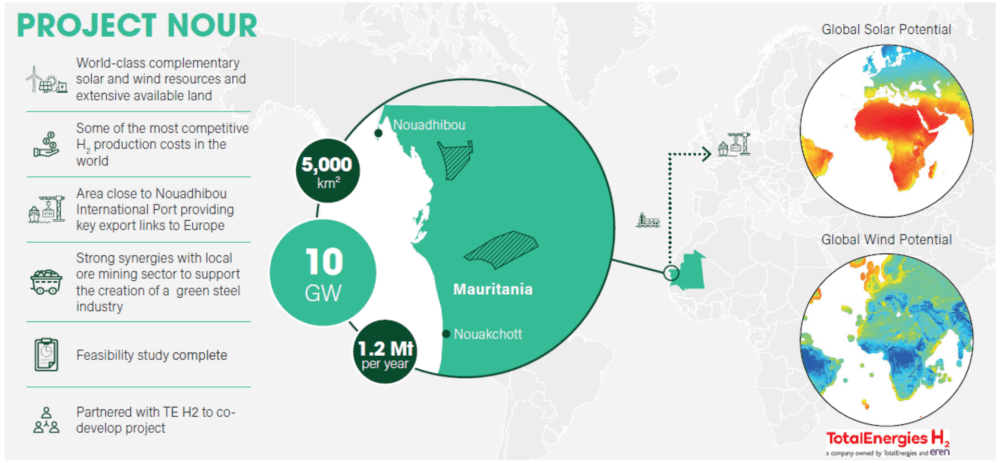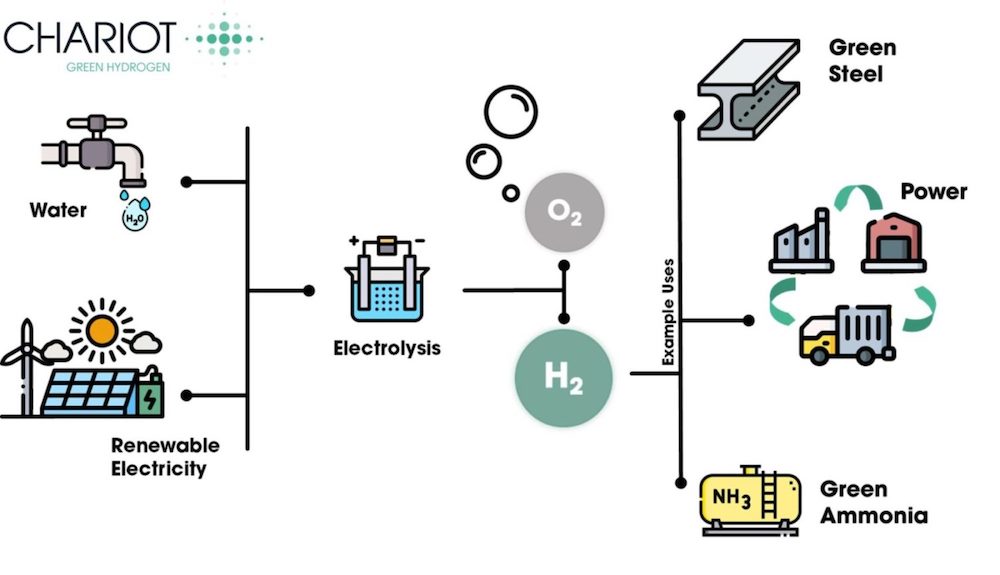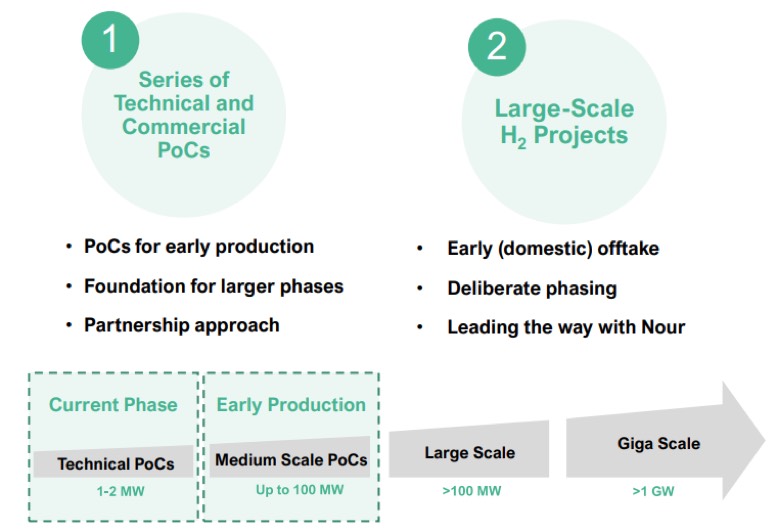Green Hydrogen
Near Term Production, Long Term Scalability
10GW
Renewable power generation potential
150 ktpa
FIRST PHASE DEVELOPMENT PLAN

PROOF OF CONCEPT PROJECTS UNDERWAY
MAURITANIA
PROJECT NOUR
Chariot’s green hydrogen project, “Project Nour”, spans two onshore areas totalling approx. 5,000km², across northern Mauritania; a location that takes advantage of the wide scale wind and solar potential, important for large-scale renewable energy generation and low-cost hydrogen production.
Project Nour is equally owned through a 50/50 partnership between Chariot’s fully owned subsidiary Chariot Green Hydrogen and TotalEnergies H2 (TEH2), a company co-owned by TotalEnergies and the EREN Group, and is being developed with the support of Mauritania’s Ministry of Petroleum, Energy and Mines. The Feasibility Study has been completed which confirmed the project’s world class potential, outlining the first phase planning of domestic offtake and export development.
Key highlights:
- Further definition of the scale and viability of the project, building on the Pre-Feasibility Study completed in 2022 which confirmed that with up to 10 GW of electrolysis installed, Project Nour could become one of the largest green hydrogen projects globally
- Intention to execute a phased development with a first phase renewable capacity of 3 GW, powering up to 1.6 GW of electrolysis capacity, to produce 150 kt of green hydrogen per annum
- Offtake possibilities: domestic use for green steel production and export of green ammonia – Nour provides a unique opportunity to tie a giga-scale green H2 project to a green steel offtaker – combining Mauritania’s power-to-X potential with the country’s longstanding iron ore industry
- Geographical proximity to Europe and existing deep-sea port at Nouadhibou provides favorable export options
- Sustainable economic development with local content plan aimed at maximizing employment and business opportunities in Mauritania
- Completed in compliance with Equator Principles and IFC Performance Standards
- Next steps include completion of investment framework, engineering conceptual study and offtake negotiations


“Chariot continues to work across its green hydrogen assets in Mauritania and Morocco with the objective of developing a portfolio of projects that has a mix of near-term production opportunities balanced with long-term scope and scale.”
Laurent Coche
CEO Chariot Green Hydrogen
THE MARKET OPPORTUNITY
Green hydrogen, created by splitting water into hydrogen and oxygen using renewable energy, has a material role to play in reaching net zero climate targets. Currently around 95% of hydrogen is produced using fossil fuels so there will be a significant transition across this sector and demand will continue to grow as the energy mix changes. There are a range of hard-to-abate sectors which currently utilise a substantial proportion of grey hydrogen but an emphasis is being placed on three key industries – steel making, fertiliser production and power fuels for transportation (including shipping and aviation); all of which Chariot is looking to address within the projects we are working on.
Hydrogen is a key building block in Europe’s climate targets and these factors were both underlined by the visit by the European Commission to Mauritania in February 2024. They publicly reaffirmed their commitment to the sector, its importance within Europe and have selected Mauritania as a key partner in the EU’s Global Gateway initiative with regard to future hydrogen export and green steel production.
LOCAL CONTENT
Green hydrogen has great potential as a catalyst for sustainable development within producing countries and hydrogen projects can deliver significant socio-economic benefits. In Mauritania, Chariot is currently developing a dedicated programme in line with the Government’s recently published local content strategy. The partnership has teamed up with an expert advisory firm to identify areas of opportunity for local businesses and assess the training needed to maximise local labour contributions, with the aim of ensuring as much in-country participation as possible. Seventeen focus areas have been identified, based upon the additional skills, certifications and capital required.
This analysis has been shared with the wider business community and selected donor organisations to help identify specific investments needed to ensure that local content is actively promoted as part of the project development process (of Nour and others) and during the tendering process.
The Chariot-TEH2 partnership is proud to be working alongside the Government of Mauritania to support its ambition to become a leading producer and exporter of green hydrogen and help the country establish itself as an attractive destinations for business and investment, while at the same time ensuring that Nour delivers in-country value in line with broader economic development.
PRODUCING GREEN HYDROGEN: THE METHOD

The two essential components of green hydrogen production are renewable electricity and water. The wider Chariot group has extensive in-house expertise in both developing large-scale renewable projects and delivering desalinated water solutions powered by renewable energy. This capacity will be a critical part of the feasibility for both Project Nour and other green hydrogen projects.
PHASING AND DE-RISKING IN MOROCCO
Chariot is focused on establishing early production on commercial basis – a deliberate phasing approach is key to de-risking projects.
Early stage, smaller scale pilots are of great importance to de-risk projects by showcasing project delivery and local value, proving up technology, as well as generating early revenues and creating the basis for deploying larger commercial phases. Chariot will continue to look at other pilots with other like-minded industry partners, as collaboration and sharing expertise and resources will be key to accelerating progression across the sector.
Chariot continues to work alongside UM6P University Mohammed VI Polytechnic (“UM6P”) and Oort Energy on developing the electrolyser pilot project in Morocco. The partnership will test a 1MW polymer electrolyte membrane electrolyser system, developed and patented by Oort, at OCP’s Jorf Lasfar industrial complex which will run capacity of the electrolyser in an industrial setting and evaluate the feasibility of larger-scale green hydrogen and ammonia production in-country.
Other pilot projects are also in discussion with large industrial players that have a long-term vested interest in green hydrogen offtake and its derivatives.


